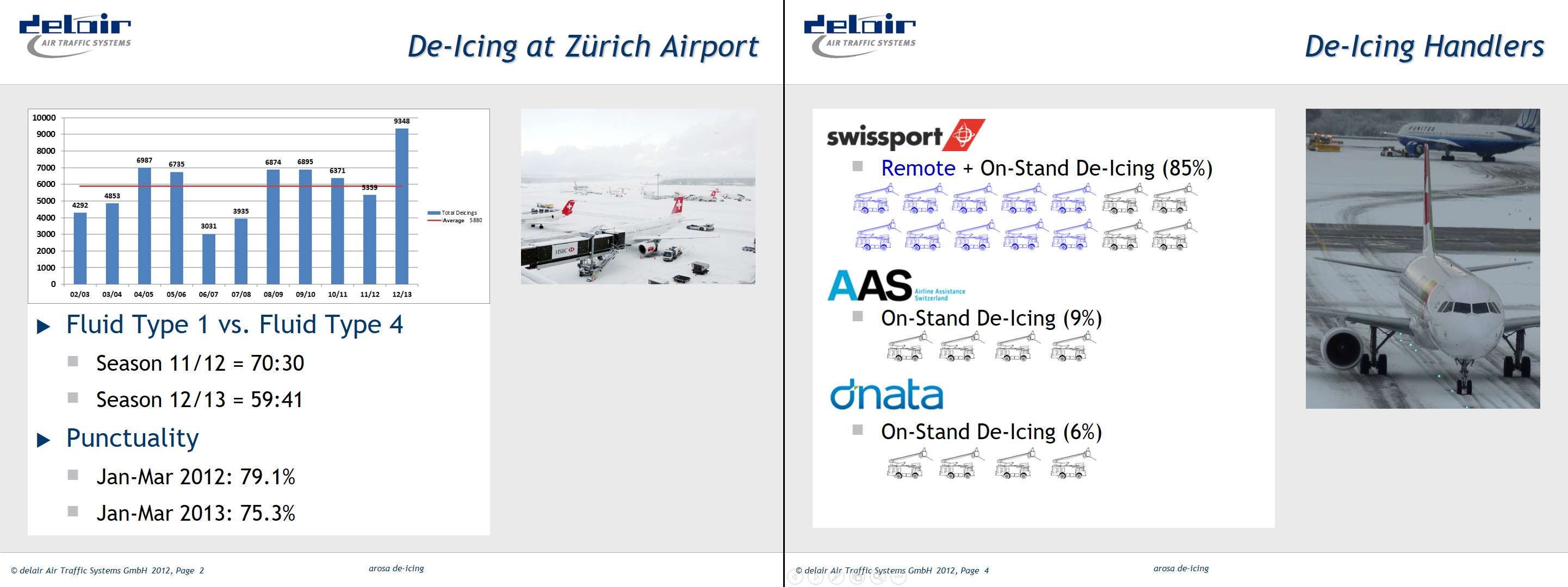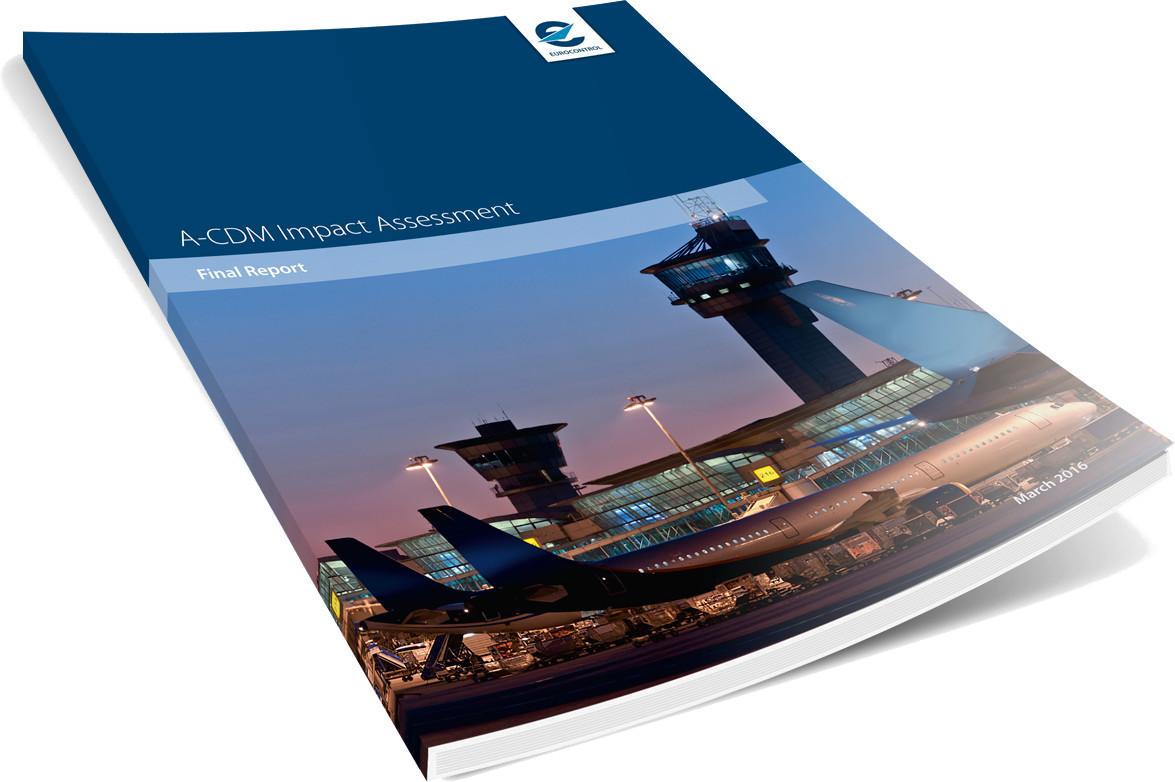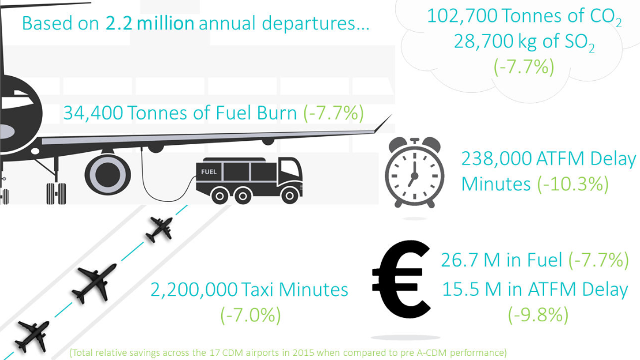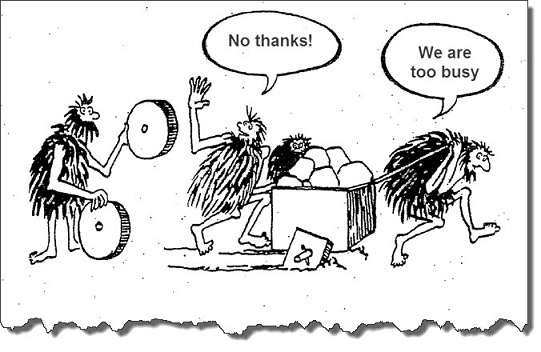This is the question I got confronted with this week, triggering me to think in more detail about it.
As you may remember, I have written a few introductions posts about A-CDM. I still believe in A-CDM and think it is something airports should implement, but much more important, airlines should demand – and jointly invest into it with their main airport partners to steer developments in the right direction.

I don’t have any access any more to the base file, but as a result on the presentation of the Zurich case study I’ve put together for WinterOps.ca, I focused on the “cash” savings, I hadn’t addressed then. We did calculate based on the performance improved expressed on slides 3 and 5 and the underlying data. We used conservative figures from IATA, Eurocontrol and FAA about the cost incurred by delay per minute. Our conservative results for Swiss (airline), the hub carrier at ZRH with a 48% market share in the given winter saved more than 20 million Euros. Even if we consider the delay cost only applicable beyond 15 minutes, the savings were above € 10 million (approx $ 13 million then). If you consider the cost to set up the system from scratch and the necessary interfaces, one single harsh winter covers up for the cost.
Similar are the savings on normal operations on the bigger airports and on all the hub airports of reasonable size.

 Now my friends in the LinkedIn group CDM@airports celebrate airport Number 20 being A-CDM compliant. And they praise the A-CDM Impact Assessment Study by Eurocontrol. Sorry if I don’t fall into the appraisal and worshiping… The new study again looks very “scientific” at the issue, just “generic” cost savings, no individual example, but such being the argument for the CFO (Chief Financial Officer). In my comments, I got the response that it’s “obvious” and the decision makers are expected to understand the cost savings intuitively. Sorry there, in my experience even when you push their nose on the $ or € amounts they tend to come up with the hen/egg principle. Why should they invest into it, what’s their benefit? And guess what: They’re right!
Now my friends in the LinkedIn group CDM@airports celebrate airport Number 20 being A-CDM compliant. And they praise the A-CDM Impact Assessment Study by Eurocontrol. Sorry if I don’t fall into the appraisal and worshiping… The new study again looks very “scientific” at the issue, just “generic” cost savings, no individual example, but such being the argument for the CFO (Chief Financial Officer). In my comments, I got the response that it’s “obvious” and the decision makers are expected to understand the cost savings intuitively. Sorry there, in my experience even when you push their nose on the $ or € amounts they tend to come up with the hen/egg principle. Why should they invest into it, what’s their benefit? And guess what: They’re right!
We got to answer that question to promote the issue.
There’s also a nice animated video about the European ATM master plan linked to the issue. Though looking at the key deliverables, I don’t find the cost savings they promote in the video. It’s again “scientific view point” where executives are to understand the cost savings from the operational improvements. But that’s exactly the point. In my experience, these chief something officers do not spend the time to think that step on their own. As such. Without some company investing into a presentation to convert those operational improvements into cash savings, why would someone want to invest into it?
But the main two questions are: What’s the cost saving for me and who should invest and why? Those questions are not properly addressed I believe.
To rephrase the first question:
Who benefits and what’s the numbers?

So Swiss at Zurich benefited from an investment by Zurich Airport in the range of what? 20 Million? In one winter alone. But Swiss did not invest. Zurich Airport is. And most airline managers I talk to go “it’s an airport thing”. Sorry. If you’re an airline operations manager and you don’t get the point, you might be over your head on operations and have no vision for your own business’s development. Understandable if you’re a small airline. Not very professional if you work for one of the big shots.
At the right, there’s the “cost savings” slide from the A-CDM Impact Assessment. Back in 2004, the DOT averaged a delay minute with $ 100, more recent figures from Eurostat, IATA or other sources are sometimes substantially higher. The study even addresses the total savings on the fuel side. though 26.8 million on 2.2 million departures don’t sound much. What misses is the amount of delays those 2.2 million departures accumulated. Then you can break it down. Or where and when those delays arose (i.e. during winter operations? ATC delays?
There’s also something we call the A-CDM delay. When flights do not leave “on time”, due to A-CDM constraints. Such your flight could have left “punctual” but sitting duck on the taxi way due to traffic jam. Instead, A-CDM keeps the flight at the gate until the A-CDM system needs it for the now jam-free departure. That’s a change in paradigms! But it’s better for everyone, so you better find a way to solve the resulting repercussions (and yes, there are ideas).
The main benefit is to the airline! Secondary benefit is to the more punctual airport, also thanks to a usual increase in “capacity”. Though it might be noteworthy that even London Heathrow found good reason to invest into A-CDM solutions.
Who should invest – and why?

There’s two opinions I was confronted over the course of the past two years. Airlines believe, that this is a “single airport issue” and should be the concern of the airport. Whereas most airport managers question, why they should invest, if the airline benefits in dollars & cents from the development. O holy dear St. Florian…
There were some good approaches as to implement the technology and charge the airline for the savings. That simply does not work, as usually there’s not a single effort to improve punctuality and airlines after tend to question the cost savings to result from that investment. Or airline managers sit back and expect the airport to be interested to provide improved punctuality. Whereas some airports openly questioned that they make more money from delayed passengers than from punctual ones. And as long as it’s not the airport to blame, why should they care too much?
Don’t get me wrong, I don’t approve either. That is an issue, I believe must be addressed by the players on a global scale! That A-CDM Impact Assessment Study was a good idea, just from a practical point of view a lousy execution. It is my honest believe that airline operations managers must understand that they got to demand A-CDM at their hub airports in order to improve on-time performance for the better of their own network. And airline and airport must find a way to benefit both on an investment. The current trend to have the airport pay and the airline to pick the raisins and savings is neither fair, nor does it help to promote comprehensive A-CDM deployment.
That also means that the airline has to invest into their OCCs (Operations Control Centers) to exchange data with the other players as explained in my post APOC, OCC, NMOC and A-CDM.
Food for Thought
Comments welcome
